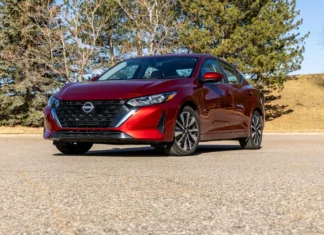
Nissan finally ends one of the longest production runs ever in building the last R35 GT-R.
Generally speaking, we don’t know when it may be the last time we do something, but Nissan has been telegraphing the current GT-R’s end for a long time now. Even then, though, it still lingered on in production, running out the clock with the same twin-turbocharged gusto it had all the way back in 2007. A year after Nissan announced that it would definitely, absolutely, finally bring an end to Godzilla’s existence, the last model finally rolled off the production line for the Japanese market: a Midnight Purple T-Spec.
Over its 18-year production run, Nissan produced about 48,000 units in Tochigi, Japan, about 100 kilometers (62 miles) north of Tokyo. Each one of those cars, from the base model to the eye-wateringly expensive Nismo and all the special editions along the way, housed a handbuilt VR38DETT 3.8-liter twin-turocharged V6 engine that took a specialized team of 9 Takumi (“artisan” or “master craftsman”) about 6 hours to build.
In addition to that engine and Nissan’s ATTESA ET-S all-wheel drive system, Godzilla traded blows with the sports car elite on the road and on the race track over the years. Even as it became long in the tooth, the R35 Nissan GT-R still put a huge smile on my face every time I drove our last loaner model, and got countless thumbs up from enthusiasts driving it around each day.
The R35 won’t be the last generation, says Nissan’s CEO
“To the many fans of the GT-R worldwide”, said Nissan CEO Ivan Espinosa at the end of the R35’s production run, “I want to tell you this isn’t a goodbye to the GT-R forever, it’s our goal for the GT-R nameplate to one day make a return.”
See, even well before the R35 met its end, rumors swirled of a replacement. Will it hark back to the legendary Skyline heritage and keep its twin-turbo V6 layout? Will it be all-electric? Will it still be a coupe, or morph into something different altogether?
We still don’t have any conclusive answers from Nissan on exactly what the next GT-R will be, of course. It is encouraging that Nissan wants to keep the nameplate going down the road, but we may be looking a long way off in the future. Unless you’ve been living under a rock, you’re likely aware of Nissan’s current vulnerabilities, with massive job cuts, plant closures and major stakeholders headed for the exits.
In fact, Mercedes-Benz just offloaded its 3.8% stake in the Japanese automaker for $325 million — a decision some analysts are painting as a canary in the coal mine, and a decision that adds further pressure on the company to successfully execute its turnaround plans.
Shares in the automaker ended the trading day Tuesday more than 6% lower on the news that Mercedes’ pension trust sold off its stake.
All that is to say, Nissan has more important and existential issues to worry about at the moment than bringing a next-generation GT-R to life. And talk is cheap: All the ambitions in the world to bring a new halo sports car to the brand could be for naught if it can’t get its affairs in order to address declining sales, its competitive status in the market and win back skeptical shareholders that it does indeed have a secure future. As it stands, all eyes are on Espinosa to make it happen, but in the meantime, we can take a moment to say a final goodbye to the current Nissan GT-R.



























